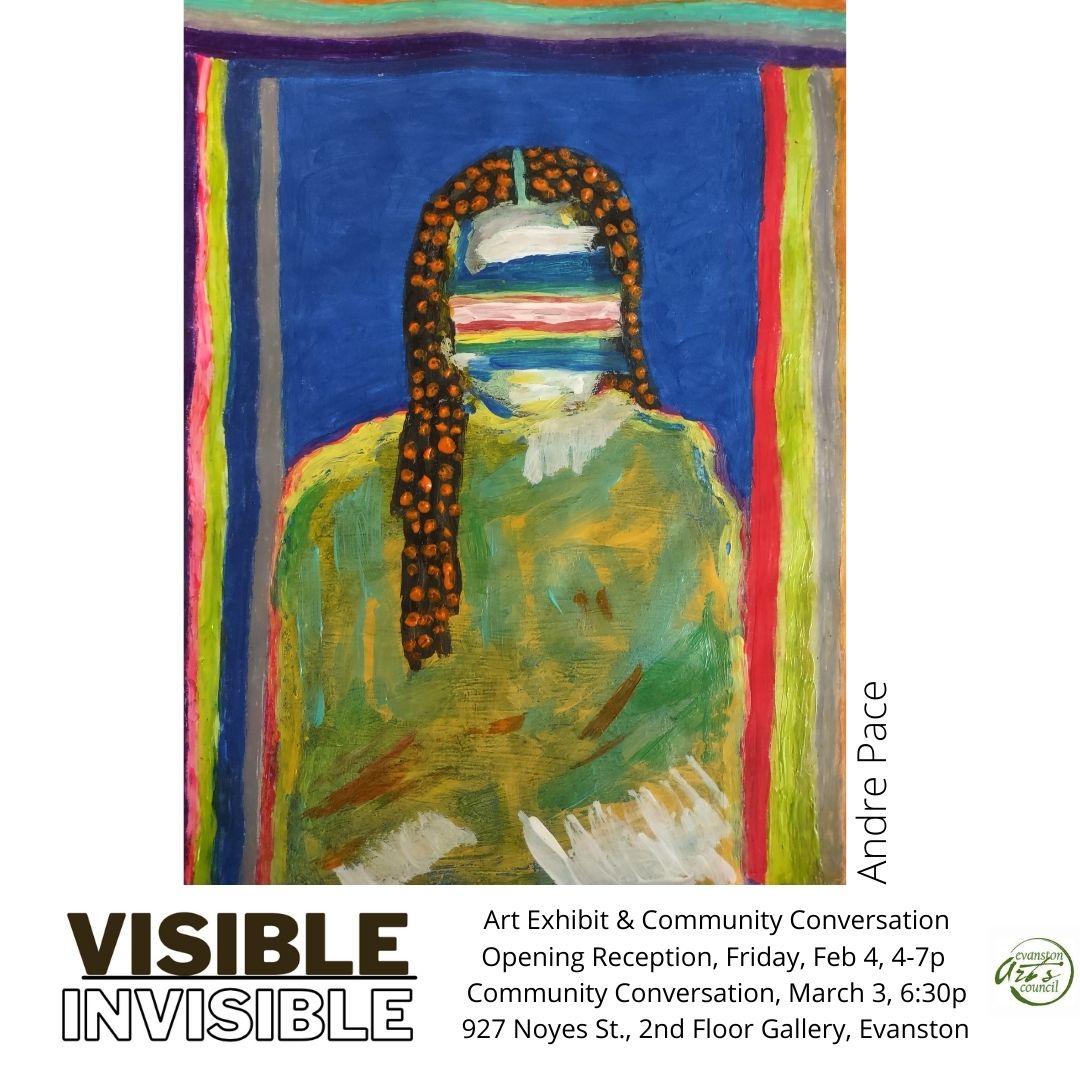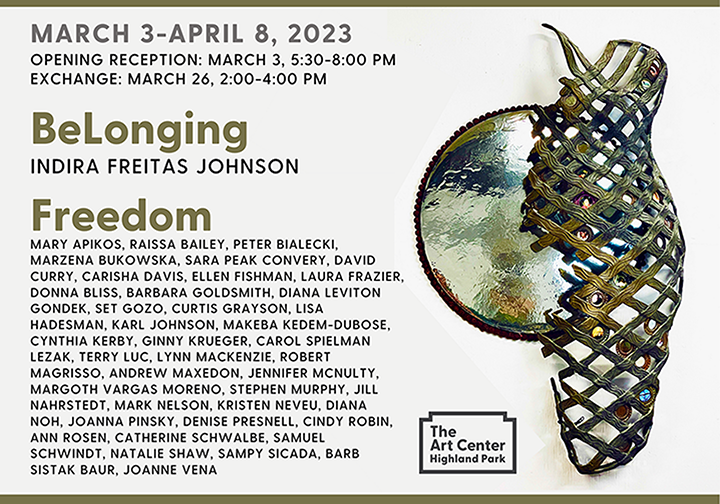BeLonging. Solo Show at the Highland Park Center
Opening Reception March 3, 2023 @5:30 to 8:00 PM
BeLonging. The Work of Indira Freitas Johnson explores the expansive and multifaceted issue of “Belonging” that runs through race, religion, ethnicity, philosophy, and sexual orientation.
The word ‘Belonging’ is a heavy word for me, fraught with contradictions and dichotomies. Today, questions of home, homeland and displacement come up in multiple ways on the global terrain.
My work in this show explores concepts of self and belonging and represents among other things attachment, rejection, regeneration, and the landscape of the everyday. The works reinforce the idea that none of us have singular identities belonging simultaneously in different geographies and cultures.
Special thanks to Curator Caren Rudman for her immeasurable help and support. And to thee Illinois Arts Council for funding a catalog of this exhibition.
Concurrent exhibition, What Does Freedom Look Like?
I am so honored to have been invited to curate this show on the theme of Freedom.
How is freedom defined and expressed through visual form? What does it look like to the individual, the community, or the world? How does an artist express through a person, a place, a moment, an event or something which in some way represents an expression freedom? Often looked at in political terms, freedom of expression is foundational in a democracy. “Without it, it is not difficult for a culture to descend into authoritarianism, fascism, and dictatorship.”
Opening Reception March 3, 2023 @5:30 to 8:00 PM
BeLonging. The Work of Indira Freitas Johnson explores the expansive and multifaceted issue of “Belonging” that runs through race, religion, ethnicity, philosophy, and sexual orientation.
The word ‘Belonging’ is a heavy word for me, fraught with contradictions and dichotomies. Today, questions of home, homeland and displacement come up in multiple ways on the global terrain.
My work in this show explores concepts of self and belonging and represents among other things attachment, rejection, regeneration, and the landscape of the everyday. The works reinforce the idea that none of us have singular identities belonging simultaneously in different geographies and cultures.
Special thanks to Curator Caren Rudman for her immeasurable help and support. And to thee Illinois Arts Council for funding a catalog of this exhibition.
Concurrent exhibition, What Does Freedom Look Like?
I am so honored to have been invited to curate this show on the theme of Freedom.
How is freedom defined and expressed through visual form? What does it look like to the individual, the community, or the world? How does an artist express through a person, a place, a moment, an event or something which in some way represents an expression freedom? Often looked at in political terms, freedom of expression is foundational in a democracy. “Without it, it is not difficult for a culture to descend into authoritarianism, fascism, and dictatorship.”

Art Exhibit: Visible / Invisible. How silence is a tool of violence allowing it to blossom and grow.
Juried Exhibit Curated by Indira Johnson, Fran Joy and Lisa Degliantoni
February 4 - March 18, 2022 @ Noyes Cultural Arts Center, Second Floor Gallery
Multi-disciplinary works are on display from a wide range of artists, who were asked to consider what kinds of violence are made visible and gain widespread public attention and what is excluded and remains invisible. From sculpture to painting to audio submissions, the diversity of art artists and mediums are impactful in the way they address this difficult topic, pervasive in our culture. More than 50 artists are participating, see full list below, and we invite you to see this event in person, February 4 - March 18, 2022 @ Noyes Cultural Arts Center, Second Floor Gallery, 927 Noyes St.
This exhibit and programs are sponsored in part by a grant made available by the Evanston Arts Council.
Events
Masks and proof of vaccination required at all events.
Additional information:
Visible Invisible explores invisible violence as it manifests itself in everyday life, in our homes, schools, workspaces and media. It brings together artists' voices and viewpoints to investigate the roots of this subversive invisible violence tracing its historical and cultural origins through language, identity related issues, representation, fluctuating socio-economic conditions and long held beliefs.
While violence has become endemic to our lives, globally, nationally and in our neighborhoods, the invisible aspects of violence remain hidden, existing behind the highly visible public incidents.
The theme of invisible violence is not new as can be seen from the increased incidents of emotional and mental abuse and the socio-economic legacy that is all around us. Visible and Invisible will explore the tangible effects of invisible violence as it manifests itself in everyday life, in our homes, schools, workspaces and media. It will bring together artists' voices and viewpoints to investigate the roots of this subversive invisible violence tracing its historical and cultural origins through language, identity related issues, representation, fluctuating socio-economic conditions and long held beliefs.
How has popular culture provided a structure that has contributed to the lack of attention and resources to fight invisible violence?
List of Participating Artists
Sarah Kaiser-Amaral Rene H. Arceo Alicia Forestall-Boehm Bradley Cahill. Salvador Campos. Sara Peak Convery Matt Cortez James Deeb Makeba Kedem DuBose Laura Easton Frazier Michael F Gallagher Diana Leviton Gondek. Kenneth Henckel Lynell Ingram Karl Johnson Rose-Marie Lamour Cynthia Kerby Stephanie Klein Pauline Kochanski William Krug Amelia Lozada George John “LARDO” Larson Siyao Lu Bob Magrisso Michaela Marchi Claudia Marter Derra McWilliams Margoth Moreno Daniel E. Murphy Stephen Murphy Mark Nelson. Tasha Nemo Kasia Ozga. Yaounde Olu Andre Pace Christine Perri Joanna Pinsky Catherine Schwalbe Jevoid Simmons Patricia A. Stewart Beth Swanson Beverly Sholo. James Totulis. Katy Washington Michael Workman Levi Yutuc Fran Joy Indira Freitas Johnson
Juried Exhibit Curated by Indira Johnson, Fran Joy and Lisa Degliantoni
February 4 - March 18, 2022 @ Noyes Cultural Arts Center, Second Floor Gallery
Multi-disciplinary works are on display from a wide range of artists, who were asked to consider what kinds of violence are made visible and gain widespread public attention and what is excluded and remains invisible. From sculpture to painting to audio submissions, the diversity of art artists and mediums are impactful in the way they address this difficult topic, pervasive in our culture. More than 50 artists are participating, see full list below, and we invite you to see this event in person, February 4 - March 18, 2022 @ Noyes Cultural Arts Center, Second Floor Gallery, 927 Noyes St.
This exhibit and programs are sponsored in part by a grant made available by the Evanston Arts Council.
Events
- Opening Reception, Friday, Feb. 4, 4-7p
- Community Conversation, March 3, 6:30p
- Hands on Family Community activity with Kids Create Change, Saturday, March 5, Time TBD
Masks and proof of vaccination required at all events.
Additional information:
Visible Invisible explores invisible violence as it manifests itself in everyday life, in our homes, schools, workspaces and media. It brings together artists' voices and viewpoints to investigate the roots of this subversive invisible violence tracing its historical and cultural origins through language, identity related issues, representation, fluctuating socio-economic conditions and long held beliefs.
While violence has become endemic to our lives, globally, nationally and in our neighborhoods, the invisible aspects of violence remain hidden, existing behind the highly visible public incidents.
The theme of invisible violence is not new as can be seen from the increased incidents of emotional and mental abuse and the socio-economic legacy that is all around us. Visible and Invisible will explore the tangible effects of invisible violence as it manifests itself in everyday life, in our homes, schools, workspaces and media. It will bring together artists' voices and viewpoints to investigate the roots of this subversive invisible violence tracing its historical and cultural origins through language, identity related issues, representation, fluctuating socio-economic conditions and long held beliefs.
How has popular culture provided a structure that has contributed to the lack of attention and resources to fight invisible violence?
List of Participating Artists
Sarah Kaiser-Amaral Rene H. Arceo Alicia Forestall-Boehm Bradley Cahill. Salvador Campos. Sara Peak Convery Matt Cortez James Deeb Makeba Kedem DuBose Laura Easton Frazier Michael F Gallagher Diana Leviton Gondek. Kenneth Henckel Lynell Ingram Karl Johnson Rose-Marie Lamour Cynthia Kerby Stephanie Klein Pauline Kochanski William Krug Amelia Lozada George John “LARDO” Larson Siyao Lu Bob Magrisso Michaela Marchi Claudia Marter Derra McWilliams Margoth Moreno Daniel E. Murphy Stephen Murphy Mark Nelson. Tasha Nemo Kasia Ozga. Yaounde Olu Andre Pace Christine Perri Joanna Pinsky Catherine Schwalbe Jevoid Simmons Patricia A. Stewart Beth Swanson Beverly Sholo. James Totulis. Katy Washington Michael Workman Levi Yutuc Fran Joy Indira Freitas Johnson
